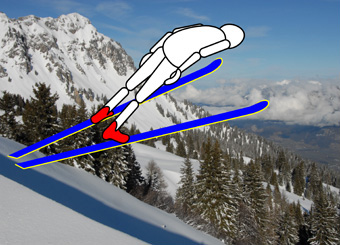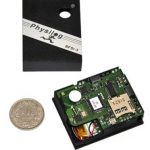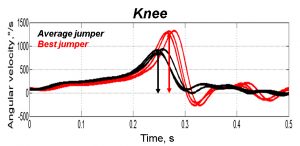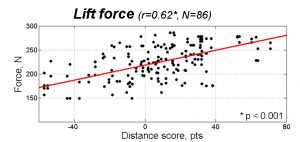ANALYSIS OF SKI JUMPING USING WEARABLE SENSORS
- Contact person: Kamiar Aminian
- People involved: Julien Chardonnens
- Partners: CHUV – UNIL, Swiss Ski
- Funding source:
Context

Ski jumping is a complex sequence of movement which should be realized in a very short period of time at 90km/h. Video camera based system is currently used to evaluate jumper performance, but it is limited in capture volume and provides a qualitative assessment. It is crucial to evaluate quantitatively and objectively the athlete performance without restriction of capture volume and to give a direct feedback to coaches and athletes. The first aim of this study was to propose a system to capture the athlete movement during the entire jump that is compatible with daily training. The second aim was to assess the reliability and the relevance of angular, coordination and dynamic parameters automatically calculated by the proposed system.

Methods
The proposed system was composed of eight inertial modules (Physilog) fixed on torso, sacrum, thighs, shanks and skis. Each module, sampled at 500 Hz, included a 3D gyroscope, a 3D accelerometer and an embedded datalogger.

33 athletes of Swiss ski team (from junior to world-class) performed up to three jumps with the proposed system. A total of 86 jumps were collected. No additional movement was required to calibrate the system and the system did not hinder the athlete.

Relevant results
Several key metrics were extracted for the entire jump sequence during training conditions and 84% (r2) of the performance variation was explained based on the most relevant metrics. In addition:
- Automatic algorithms provided timing, angular movements, forces and coordination metrics
- A laboratory validation highlighted precise metrics
- Regression analysis showed which metrics influenced performance

Journal papers
Chardonnens, J., Favre, J., Cuendet, F., Gremion, G., Aminian, K., A system to measure the kinematics during the entire ski jump sequence using inertial sensors, Journal of Biomechanics, In Press, 2012.
Chardonnens, J., Favre, J., Le Callenec, B., Cuendet, F., Gremion, G., Aminian, K., Automatic measurement of key ski jumping phases and temporal events with a wearable system, Journal of Sports Sciences, vol. 30, num. 1, p. 53-61, 2012
Book section
Chardonnens, J., Favre, J., Cuendet, F., Gremion, G., Aminian, K., A wearable system assessing relevant characteristics of the take-off in ski jumping, in Science & Skiing, Ed. by num. Vol V, p. 599-607, 2012
Conference papers
Chardonnens, J., Favre, J., Cuendet, F., Gremion, G., Aminian, K., Analysis of inter-segment coordination during the take-off of ski jumping. In ISB, Brussel, Belgium, 2011
Chardonnens, J., Favre, J., Cuendet, F., Gremion, G., Aminian, K., A new wearable system assessing the main relevant metrics of the whole ski jumping sequence. In ICSS, St Christophe, Austria, 2010
Chardonnens, J., Favre, J., Cuendet, F., Gremion, G., Aminian, K., Analysis of Stable Flight Phase in Ski Jumping Based on Parameters Measured with a Wearable System, In ISBS, Marquette, USA, p.273-275, 2010
Aminian, K., Chardonnens, J., Favre, J., Cuendet, F., Gremion G, Orientation of body segments in ski jumps using wearable sensors: Analysis of relevant parameters during stable flight phase, In ISB 3DMA, San Francisco, USA, 2010
Aminian, K., Le Callennec, B., Chardonnens, J., Cuendet, F., Gremion G, Jolles, B.M., Estimation of temporal parameters in ski jumps using wearable sensors, In ISB, Cape Town, South Africa, 2009
Awards
FIS New Investigator Award for the first best oral presentation in International Conference on Science and Skiing (2010).
Hans Gross New Investigator Award for the second best oral presentation in International Conference on Biomechanics in Sport (2010).
TV reports
25th January 2011 – TSR news & Nouvo (scientific program) will report the main results and the practical (daily training analysis) use of the Ski Jumping project for Swiss ski team (Ammann interview).
9th January 2011 – Il Giardino di Albert – a RSI scientific TV program – presented the ski jumping research project, with Simon Ammann interview